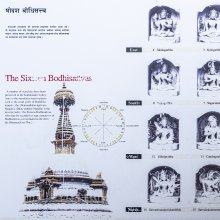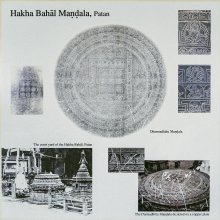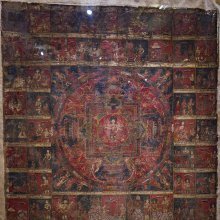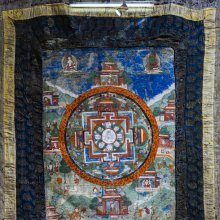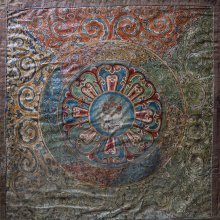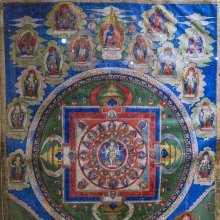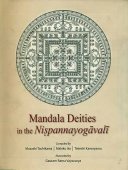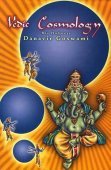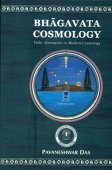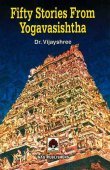Mandala, Maṇḍala, Maṇḍalā, Mamdala: 51 definitions
Introduction:
Mandala means something in Buddhism, Pali, Hinduism, Sanskrit, Jainism, Prakrit, the history of ancient India, Marathi, biology. If you want to know the exact meaning, history, etymology or English translation of this term then check out the descriptions on this page. Add your comment or reference to a book if you want to contribute to this summary article.
Images (photo gallery)
(+167 more images available)
In Hinduism
Ayurveda (science of life)
Source: Wisdom Library: Āyurveda and botanyMaṇḍala (मण्डल):—One of the eighteen types of Kuṣṭha (“skin disease”), according to the Caraka-saṃhitā (cikitsāsthāna), which is an important Sanskrit work dealing with Āyurveda. This condition of the skin (kuṣṭha) is caused by the corruption of the three doṣas (tridoṣa: vāta, pitta and kapha) which in turn corrupts the skin, blood, muscle and lymph. Maṇḍala-kuṣṭha is characterized by white and red colors, dense, oily and raised circles. Maṇḍala is caused by a preponderance of Pitta-doṣa (‘bodily bile’).
Source: archive.org: Sushruta samhita, Volume IIIMandala (or sub-divisions or circles of the eye-ball). The Mandalas of the eye are the following, viz.,
- the Pakshma-mandala (the circle of the eye-lashes),
- the Vartma-mandala (the eye-lid)
- the Sveta-mandala (the Sclerotic and Cornea), the Krishna-mandala (the choroid)
- and the Drishti-mandala (the pupil).
These circles are so arranged that the one preceding lies within the next in the list.
Source: gurumukhi.ru: Ayurveda glossary of termsMaṇḍala (मण्डल):—Circular patch, Round shaped

Āyurveda (आयुर्वेद, ayurveda) is a branch of Indian science dealing with medicine, herbalism, taxology, anatomy, surgery, alchemy and related topics. Traditional practice of Āyurveda in ancient India dates back to at least the first millenium BC. Literature is commonly written in Sanskrit using various poetic metres.
Shaktism (Shakta philosophy)
Source: Wisdom Library: ŚāktismMaṇḍala (मण्डल):—According to Śākta-tantra, in the cakra or maṇḍala, the highest principle (gradual evolution of cosmic creation) is represented in the central point and unfolds itself outwards, thus expressing the idea of creative multiplication. The powers which are active on both the phenomenal and phonic levels in this process may be symbolized as divine figures, male or female, who are either depicted in iconographic form or represented in sonic form by their seed-syllables. The centre is thus occupied by the main deity who is surrounded by partial manifestations. In this way the components of the manifested world, as well as related philosophical concepts, are arranged into a system according to the underlying religious-philosophical theories about creation.
As an object of meditation, the diagram is a means to effect a mental reconstruction of the process of creation into its original source. By meditating on the powers the practitioner is enabled to identify himself with them, by which process he gradually realizes his identity with the ultimate reality.
Source: Google Books: Manthanabhairavatantram1) Maṇḍala (मण्डल) (cf. Mantra, Krama) refers to the spatial ordering of mantras by virtue of which they work together.—A maṇḍala has no existence apart from its parts but it is much more than just their sum. Maṇḍala is the spatial ordering of its parts by virtue of which they work together as a whole. A maṇḍala is like a machine. Machines work because their parts are configured correctly. If we pull apart the parts of a watch it no longer tells the time. In the case of maṇdalas these parts are mantras.
Note: The union of the god with the goddess in the centre of the maṇḍala is the model and the culmination of numerous unions great and small through and for which the parts of the maṇḍala, more or less complex, are configured.
2) Maṇḍala (मण्डल) refers to “round (breasts)”, according to the Kulakaulinīmata 5.88-99.—Accordingly, “The goddess (Tripurabhairavī) is red like vermillion and the Bandhūka flower. She wears red clothes and is adorned with all the ornaments. She has matted hair and, peaceful, the moon is her crest jewel. She is replete with all (auspicious) characteristics and sits on a cot. She has large, round [i.e., āpīna-maṇḍala-ābhoga] and upraised breasts, her navel has three folds, and she is adorned with (a fine) line of hair (travelling down from it). [...]”.

Shakta (शाक्त, śākta) or Shaktism (śāktism) represents a tradition of Hinduism where the Goddess (Devi) is revered and worshipped. Shakta literature includes a range of scriptures, including various Agamas and Tantras, although its roots may be traced back to the Vedas.
Vastushastra (architecture)
Source: The India Center: Architecture (Vastu Shastra)The Vastu Purusha Mandala is an indispensable part of vastu shastra and constitutes the mathematical and diagrammatic basis for generating design. It is the metaphysical plan of a building that incorporates the coursly bodies and supernatural forces. Purusha refers to energy, power, soul or cosmic man. Mandala is the generic name for any plan or chart which symbolically represents the cosmos.
Source: OpenEdition books: Architectural terms contained in Ajitāgama and RauravāgamaMaṇḍala (मण्डल) refers to “- 1. convolution (visible on a stone) § 2.10. - 2. “circle” (made up of the eight Principal Assessors) § 5.14.”.—(For paragraphs cf. Les enseignements architecturaux de l'Ajitāgama et du Rauravāgama by Bruno Dagens)

Vastushastra (वास्तुशास्त्र, vāstuśāstra) refers to the ancient Indian science (shastra) of architecture (vastu), dealing with topics such architecture, sculpture, town-building, fort building and various other constructions. Vastu also deals with the philosophy of the architectural relation with the cosmic universe.
Dharmashastra (religious law)
Source: Wisdom Library: Dharma-śāstraMaṇḍala (मण्डल) refers to the “group of powerful sovereigns”. It is used throughout Dharmaśāstra literature such as the Manusmṛti and the Baudhāyana-dharmasūtra.
Source: Shodhganga: Facts of society in the ManusamhitaMaṇḍala (मण्डल):—The maṇḍala is a technical term to indicate the group of power ful sovereigns. There are all total seventy two varieties of king included in the maṇḍala. The circle of sovereigns (mūlamaṇḍala) includes four types of powerful kings.
These are named as
- Madhyama (intermediate),
- Vijigīṣu (ambitious),
- Udāsīna (nutrel)
- and Śatru (enemy).
These are four main (prakṛ) in a Rājamaṇḍala. The very important duty of king is to ponder on each and every movement of these strong political powers.

Dharmashastra (धर्मशास्त्र, dharmaśāstra) contains the instructions (shastra) regarding religious conduct of livelihood (dharma), ceremonies, jurisprudence (study of law) and more. It is categorized as smriti, an important and authoritative selection of books dealing with the Hindu lifestyle.
Natyashastra (theatrics and dramaturgy)
Source: Wisdom Library: Nāṭya-śāstra1) Maṇḍala (मण्डल) refers to “combination of three or four khaṇḍas”. According to the Nāṭyaśāstra, it is one of the four classes of ‘movements of the feet’. These movements are part of the ‘physical representation’ (āṅgika), which is used in communicating the meaning of the drama and calling forth the sentiment (rasa).
2) Maṇḍala (मण्डल) also refers to a specific gesture (āṅgika) , or “movements made with the arms (bāhu)”, according to the Nāṭyaśāstra chapter 9. These movements form a part of the histrionic representation (abhinaya).
2) Maṇḍala (मण्डल) also refers to a combination of cārīs (“dance-steps”), according to the Nāṭyaśāstra chapter 12. Accordingly, “these maṇḍalas to be used in fight and personal combat, are to be performed with sportiveness and graceful movements of limbs, and should be accompanied by suitable instrumental music.”
There are ten maṇḍalas of the ‘aerial’ (ākāśa) type defined:
- atikrānta,
- vicitra,
- lalitasañcara,
- sūcividdha,
- daṇḍapāda,
- vihṛta,
- alāta (alātaka),
- vāmaviddha,
- lalita,
- krānta.
There are ten maṇḍalas of the ‘earthly’ (bhūmi) type defined:
- bhramara,
- āskandita,
- āvarta,
- samotsarita,
- eḍakākrīḍīta,
- aḍḍita,
- śakaṭāsya,
- adhyardha (adhyardhaka),
- piṣṭakuṭṭa,
- cāṣagata.
Maṇḍala (मण्डल).—A type of standing-posture (sthāna);—Instructions: it relates to Indra (i.e. its presiding deity is Indra). In it the feet are four Tālas apart and they are obliquely placed and turned sideways, the waist and the knee are in the natural position.
(Uses): The Maṇḍala Sthāna should be assumed in the use of weapons like the bow and the thunderbolt, driving of elephants, and mimicking large birds.
Source: Shodhganga: The significance of the mūla-beras (natya)1) Maṇḍala means to “separate the legs leaving twelve toes’ interval” and represents one of six positions of the legs used in kūttu (dance) as defined in the first book of the Pañcamarapu (‘five-fold traditional usage’) which deals with niruttam (dance, one of the sixty–four arts) and represents an important piece of Tamil literature.—The Pañcamarapu (“five-fold traditional usage”) refers to a book on five established literary usages (five-fold traditional usages) defines terms such as Maṇḍala. It was composed by Cerai Aṟivanār in the 9th century AD during the time of Pandyan Tirumaran of the last Caṅkam Period.
2) Maṇḍala also referers to the “interval between the two heels”, representing one of five actions of the foot used in kūttu (dance)
3) Maṇḍala (मण्डल) refers to the “various postures of the feet” and represents one of the four “movements of the feet” (pāda) according to the Abhinayadarpaṇa. The feet (pāda) also represents one of the seven “major limbs” (aṅga), which represents a division of Āṅgikābhinaya (gesture language of the limbs) as used within the classical tradition of Indian dance and performance, also known as Bharatanatyam.
The ten maṇḍalas-bhedas (postures of the feet) are:—
- sthānaka,
- āyata,
- ālīḍha,
- preṅkhaṇa,
- prerita,
- pratyālīḍha,
- moṭita,
- samasūcī,
- pārśvasūcī.
Maṇḍala (मण्डल) refers to “one of the six kinds of standing postures for Men” (in Indian Dramas), according to the Viṣṇudharmottarapurāṇa, an ancient Sanskrit text which (being encyclopedic in nature) deals with a variety of cultural topics such as arts, architecture, music, grammar and astronomy.—Standing postures are determined separately for male and female. In the Viṣṇudharmottarapurāṇa six kinds of standing postures are discussed for men. In the maṇḍala posture the distance between two legs should be three tālas and it should be adopted to show the striking action with bow and thunderbolt. According to the Viṣṇudharmottarapurāṇa, the maṇḍala posture becomes āliḍha when the distance between two legs is five tālas.

Natyashastra (नाट्यशास्त्र, nāṭyaśāstra) refers to both the ancient Indian tradition (shastra) of performing arts, (natya—theatrics, drama, dance, music), as well as the name of a Sanskrit work dealing with these subjects. It also teaches the rules for composing Dramatic plays (nataka), construction and performance of Theater, and Poetic works (kavya).
Purana and Itihasa (epic history)
Source: archive.org: Puranic EncyclopediaMaṇḍala (मण्डल) or Maṇḍalavyūha refers to the “Disposition of an army in the shape of a circle”.—Disposition of an army (vyūha) of four parts, (infantry, cavalry, elephants and chariots) in the battlefield, the arrangement of it, in various forms. It is said that during the period of Mahābhārata, there were various forms of disposition of the army.—Maṇḍala-vyūha is mentioned in the Mahābhārata Bhīṣma Parva, Chapter 81.
Source: Cologne Digital Sanskrit Dictionaries: The Purana Index1a) Maṇḍala (मण्डल).—A mountain kingdom.*
- * Matsya-purāṇa 114. 56.
1b) (Vartula): a palace in the form of a circle; the toraṇa is twenty hastas.*
- * Matsya-purāṇa 269. 36, 49.
1c) Of the sun; the place of all planets, stars and the moon.*
- * Vāyu-purāṇa 53. 28.
1d) (Brāhmaṇam) to be selected for recitation at śrāddha.*
- * Matsya-purāṇa 17. 39.
1e) A place near Prayāgā protected by Hari;1 five yojanas in extent;2 every step there, is equal to an aśvamedha.3
2) Maṇḍalā (मण्डला).—One of the ten pīṭhas for images; round in shape with a number of mekhalas.*
- * Matsya-purāṇa 262. 6, 9, 17.

The Purana (पुराण, purāṇas) refers to Sanskrit literature preserving ancient India’s vast cultural history, including historical legends, religious ceremonies, various arts and sciences. The eighteen mahapuranas total over 400,000 shlokas (metrical couplets) and date to at least several centuries BCE.
Shaivism (Shaiva philosophy)
Source: IGNCA: Āgamic Treatment Of Mahābhūtas In Relation To Maṇḍalas And ArtsMaṇḍala (मण्डल).—Being an artistic device, maṇḍala incorporates in itself all the significant aspects of symbols, sounds, forms, colours and divinities, with a stronghold on metaphysical and ontological principles. The Āgamas excel all other scriptures with their elaborate and effective details and descriptions of various maṇḍalas. In the Saivagamic group, the Kiraṇāgama is held in high esteem owing to its copious details and directions on the mechanism of maṇḍalas.
Maṇḍala is an aesthetic and mystic design in which the combination and in-tersection of various forms related to the gross elements and to the deities concerned have their full play. The correspondence of colours, the distribution of letters (mātṛkā-akṣaras) and the esoteric significance enhance the mystic value of maṇḍalas.
Source: Brill: Śaivism and the Tantric TraditionsMaṇḍala (मण्डल) refers to a “(lunar) disc”.—The moon also forms an important element of Pāśupata yogic practices. As we learn from the Skandapurāṇa (179.28ff.), as pointed out by Bakker (2015, 141), their “accomplishment in yoga” comes about through a process of withdrawing the senses until the practitioner can see a lunar disc (soma-maṇḍala) in his heart. From the moonlight within his body, yogic powers, omniscience and the like arise. These powers include being immune to disease and possessing a divine body.
Source: SOAS University of London: Protective Rites in the Netra TantraMaṇḍala (मण्डल) refers to a class of “mystical diagrams”.—Maṇḍalas, like mantras, are not symbolic representations of the divine. They are physical structures that function as devices through which a practitioner witnesses deities. During rites, the practitioner views the deities in the maṇḍala, not as icons but as literal manifestations of the deities.
Note: The terms maṇḍala, cakra, and yantra are each often translated as “mystical diagram”. These diagrams serve as spaces for ritual practice and are created so that the deities can appear within them. Each type has its own frequent characteristics, such as maṇḍalas usually including lotus petals or being drawn as square grids. These diagrams are regularly, though certainly not always, made for ritual and destroyed afterward. At times they are big enough for practitioners to enter them and the colors used have symbolic ritual meaning. Bühnemann, 2003, p. 15, shows that cities are routinely said to be based on maṇḍalic mapping, but that the actual connection between architectural or city design and maṇḍala is much more tenuous than it is widely assumed.

Shaiva (शैव, śaiva) or Shaivism (śaivism) represents a tradition of Hinduism worshiping Shiva as the supreme being. Closely related to Shaktism, Shaiva literature includes a range of scriptures, including Tantras, while the root of this tradition may be traced back to the ancient Vedas.
Arthashastra (politics and welfare)
Source: archive.org: Personal and geographical names in the Gupta inscriptions (artha)Maṇḍala (मण्डल) denoted in the Arthaśāstra and other legal texts, a diplomatic circle of twelve neighbouring kings, some friendly and others unfriendly, in relation to a king desirous of conquest. The term could also be used for the territory under the possession of a feudatory.

Arthashastra (अर्थशास्त्र, arthaśāstra) literature concerns itself with the teachings (shastra) of economic prosperity (artha) statecraft, politics and military tactics. The term arthashastra refers to both the name of these scientific teachings, as well as the name of a Sanskrit work included in such literature. This book was written (3rd century BCE) by by Kautilya, who flourished in the 4th century BCE.
Jyotisha (astronomy and astrology)
Source: Wisdom Library: Brihat Samhita by Varahamihira1) Maṇḍala (मण्डल) refers to the “lunar disc”, according to the Bṛhatsaṃhitā (chapter 4), an encyclopedic Sanskrit work written by Varāhamihira mainly focusing on the science of ancient Indian astronomy astronomy (Jyotiṣa).—Accordingly, “If the disc of the moon that regularly waxes and wanes should appear white resembling the colour of the Kumuda flower or that of the stem of the lotus or if the moon’s course or disc [i.e., maṇḍala] or rays should suffer no irregular change there will be prosperity in the land. During the waxing moon, the Brāhmins, the Kṣatriyas and mankind at large will prosper; and during the waning moon, they will suffer miseries. The increase of prosperity will commence after the new-moon and of adversity after the full moon”.
2) Maṇḍala (मण्डल) refers to a “circle” or “division” (of the sky), according to the Bṛhatsaṃhitā (chapter 9).—Accordingly, “The four constellations from Bharaṇi are known as the first maṇḍala (circle or division). If Venus should reappear in it there will be prosperity in the land; the people of Vaṅga and of Aṅga, the Mahiṣas, the Vāhlīkās and the Kaliṅgas will be afflicted with fears. If Venus, who so reappears in the said circle, should be crossed by a planet, the rulers of the Bhadrās, of the Aśvas, of Śūrasenakas and of the Yaudheyas and Koṭivarṣa will perish”.
Source: Google Books: Studies in the History of the Exact Sciences (Astronomy)Maṇḍala (मण्डल) or Sūryamaṇḍala refers to the “Sun’s orb”, according to Kāśīnātha Upādhye’s Dharmasindhu, a commentary on the Rāma Daivajña’s Muhūrtacintāmaṇi (an astrological work).—Accordingly, “[...] The water clock [i.e., ghaṭīyantra], thus calibrated, should be placed in a copper basin or clay basin, full of water, when half of the Sun’s orb [i.e., sūrya-maṇḍala-ardha] has risen or set. There this sacred formula is recited. ‘You have been created long time ago by Brahmā as the foremost among the [time measuring] instruments. For the sake of the state of [their] becoming a married couple you be the means of measuring time’. With this sacred formula, preceded by the worship of Gaṇeśa and Varuṇa, the bowl should be placed [on the water in the basin]. If the bowl thus placed moves to the south-east, south, south-west, or north-west of the basin, it is not auspicious. If it stays in the middle, or moves to other directions, it is auspicious. Likewise, if it fills [and sinks] in the five directions starting from the southeast, it is not auspicious. Thus the discussion of the water clock. [...]”.
Source: Wikibooks (hi): Sanskrit Technical TermsMaṇḍala (मण्डल).—Circle, revolution. Note: Maṇḍala is a Sanskrit technical term used in ancient Indian sciences such as Astronomy, Mathematics and Geometry.

Jyotisha (ज्योतिष, jyotiṣa or jyotish) refers to ‘astronomy’ or “Vedic astrology” and represents the fifth of the six Vedangas (additional sciences to be studied along with the Vedas). Jyotisha concerns itself with the study and prediction of the movements of celestial bodies, in order to calculate the auspicious time for rituals and ceremonies.
Yoga (school of philosophy)
Source: Brill: Śaivism and the Tantric Traditions (yoga)Maṇḍala (मण्डल) refers to the “orb” (of the sun), according to the Amṛtasiddhi, a 12th-century text belonging to the Haṭhayoga textual tradition.—Accordingly, “At the navel is a white lotus. On top of that is the spotless orb (maṇḍala—vimalaṃ maṇḍalaṃ) of the sun. In the middle of that, at the triple pathway, is she who is the sole essence of saṃsāra [and] the creator of the three worlds, who arises on the path of dharma, who has three bodies [and] who is lauded as Chinnamastā, “she whose head is cut.” I worship her, she who has the form of knowledge, who removes the danger of death, the Yoginī, the seal of Yoga”.

Yoga is originally considered a branch of Hindu philosophy (astika), but both ancient and modern Yoga combine the physical, mental and spiritual. Yoga teaches various physical techniques also known as āsanas (postures), used for various purposes (eg., meditation, contemplation, relaxation).
Pancaratra (worship of Nārāyaṇa)
Source: University of Vienna: Sudarśana's Worship at the Royal Court According to the AhirbudhnyasaṃhitāMaṇḍala (मण्डल) refers to a “provincial”, according to the Ahirbudhnyasaṃhitā, belonging to the Pāñcarātra tradition which deals with theology, rituals, iconography, narrative mythology and others.—Accordingly, “A ruler who is a Universal Sovereign is entitled to the first, a Provincial Governor (maṇḍala-īśvara) to the second and a District Governor to the third [level of] Creative Energy. [To the same are entitled] a chief minister or a twice-born, provided he is in charge of the protection of many people. No single man is entitled to [deploy] Her for [just] another man”.

Pancaratra (पाञ्चरात्र, pāñcarātra) represents a tradition of Hinduism where Narayana is revered and worshipped. Closeley related to Vaishnavism, the Pancaratra literature includes various Agamas and tantras incorporating many Vaishnava philosophies.
Sports, Arts and Entertainment (wordly enjoyments)
Source: archive.org: Syainika Sastra of Rudradeva with English Translation (art)Maṇḍala (मण्डल) refers to a “(hunting) circle” (accompanying the chief hawker), according to the Śyainika-śāstra: a Sanskrit treatise dealing with the divisions and benefits of Hunting and Hawking, written by Rājā Rudradeva (or Candradeva) in possibly the 13th century.—Accordingly, [while discussing the outlines of hawking]: “[...] At the middle of the party there should be the leading hawker, with two soldiers on each side. The circle (maṇḍala) should be made with twenty-one horsemen. All men in the circle, with their eyes fixed on the chief hawker, should remain at a distance of four cubits from each other, in two equal divisions on each side. [...]”.

This section covers the skills and profiencies of the Kalas (“performing arts”) and Shastras (“sciences”) involving ancient Indian traditions of sports, games, arts, entertainment, love-making and other means of wordly enjoyments. Traditionally these topics were dealt with in Sanskrit treatises explaing the philosophy and the justification of enjoying the pleasures of the senses.
In Buddhism
Tibetan Buddhism (Vajrayana or tantric Buddhism)
Source: academia.edu: A Critical Study of the Vajraḍākamahātantrarāja (II)Maṇḍala (मण्डल) is the name of a Vākchomā (‘verbal secrect sign’) which has its meaning defined as ‘sama’ according to chapter 8 of the 9th-century Vajraḍākamahātantrarāja, a scripture belonging to the Buddhist Cakrasaṃvara (or Saṃvara) scriptural cycle. These Vākchomās (viz., maṇḍala) are meant for verbal communication and can be regarded as popular signs, since they can be found in the three biggest works of the Cakrasaṃvara literature.

Tibetan Buddhism includes schools such as Nyingma, Kadampa, Kagyu and Gelug. Their primary canon of literature is divided in two broad categories: The Kangyur, which consists of Buddha’s words, and the Tengyur, which includes commentaries from various sources. Esotericism and tantra techniques (vajrayāna) are collected indepently.
Mahayana (major branch of Buddhism)
Source: academia.edu: A Study and Translation of the GaganagañjaparipṛcchāMaṇḍala (मण्डल) refers to a “circle”, according to the Gaganagañjaparipṛcchā: the eighth chapter of the Mahāsaṃnipāta (a collection of Mahāyāna Buddhist Sūtras).—Accordingly, as Bodhisattva Gaganagañja explains to Bodhisattva Ratnaśrī what kind of concentration should be purified: “[...] (28) [when the Bodhisattvas attain] the concentration called ‘Being endowed with a core’, all promises will be carried out; (29) [when the Bodhisattvas attain] the concentration called ‘Circle of diamond’ (vajra-maṇḍala-samādhi), supernormal knowledges will be never given up; (30) [when the Bodhisattvas attain] the concentration called ‘Vajra-essence’, they will go to the essence of awakening; [...]”.

Mahayana (महायान, mahāyāna) is a major branch of Buddhism focusing on the path of a Bodhisattva (spiritual aspirants/ enlightened beings). Extant literature is vast and primarely composed in the Sanskrit language. There are many sūtras of which some of the earliest are the various Prajñāpāramitā sūtras.
General definition (in Buddhism)
Source: Wisdom Library: BuddhismMandala:—An object of focus, which allows the practitioner to naturally produce a state of Buddhahood.
Source: Buddhist Door: GlossaryA diagrammatic circular picture used as an aid in meditation or ritual, sometimes a symbol of the universe, or a representation of a deed of merit. Sometimes, it represents a place of enlightenment, where Buddhas and Bodhisattvas are existent. Mandalas also reveal the direct retribution of each of the ten worlds of beings (see Ten Realms). Each world has its mandala which represents the originating principle that brings it to completion. It is one of the three mystics in Tantric Buddhism.In Jainism
General definition (in Jainism)
Source: archive.org: Een Kritische Studie Van Svayambhūdeva’s PaümacariuMaṇḍala (मण्डल) participated in the war between Rāma and Rāvaṇa, on the side of the latter, as mentioned in Svayambhūdeva’s Paumacariu (Padmacarita, Paumacariya or Rāmāyaṇapurāṇa) chapter 57ff. Svayambhū or Svayambhūdeva (8th or 9th century) was a Jain householder who probably lived in Karnataka. His work recounts the popular Rāma story as known from the older work Rāmāyaṇa (written by Vālmīki). Various chapters [mentioning Maṇḍala] are dedicated to the humongous battle whose armies (known as akṣauhiṇīs) consisted of millions of soldiers, horses and elephants, etc.

Jainism is an Indian religion of Dharma whose doctrine revolves around harmlessness (ahimsa) towards every living being. The two major branches (Digambara and Svetambara) of Jainism stimulate self-control (or, shramana, ‘self-reliance’) and spiritual development through a path of peace for the soul to progess to the ultimate goal.
India history and geography
Source: Google Books: Manthanabhairavatantram (history)Maṇḍala (मण्डल) refers to a “cricle”.—The circle is a universal symbol of wholeness. It is the appropriate shape of the Liṅga that enshrines the energy through which the universe is generated, sustained and into which it is ultimately withdrawn. The symbol is a powerful one, drawn from nature and our own human world; it is spontaneously understood.
Far from the Indian subcontinent, in North America, the Sioux Indian visionary Black Elk expresses the wisdom of his people in similar terms: “Everything the Power of the World does is done in a circle [i.e., maṇḍala]. The sky is round, and I have heard that the earth is round like a ball, and so are all the stars. The wind, in its greatest power, whirls. Birds make their nests in circles, for theirs is the same religion as ours. The sun comes forth and goes down again in a circle. The moon does the same, and both are round. Even the seasons form a great circle in their changing, and always come back to where they were. The life of a man is a circle from childhood to childhood, and so it is in everything where power moves. Our tepees were round like the nests of birds, and these were always set in a circle, the nation's hoop, a nest of many nests, where the Great Spirit meant for us to hatch out children”.
Source: archive.org: Personal and geographical names in the Gupta inscriptionsMaṇḍala (मण्डल) refers to a name-ending for place-names mentioned in the Gupta inscriptions (reigned from 3rd century CE). Maṇḍala is a territorial unit which is found in the inscriptions of many dynasties of the early medieval period. In the Gupta period maṇḍala is used for some kind of administrative division though in early medieval period its use was in feudalistic association. In Cālukyan records, the governor of a maṇḍala was usually called a Maṇḍaleśvara or Mahamaṇḍaleśvara. In the records of the Imperial Guptas it denoted a unit smaller than a vīthī. Literally meaning a circle or round it denotes a district, province, country in general or it may signify a surrounding district or neighbouring state.
Source: Early History Of The Deccan Pts.1 To 6: Principal Administrative Divisions from the Rise of the SātavāhanasMaṇḍala (मण्डल, “circle”) refers to an “administrative designation”.—Maṇḍala, literally a circle (of territory), is alluded to in the Nāsik eulogy of Gautamīputra Śātakarṇi, in which that great king is described as one ‘whose feet were saluted by all provinces’. In the time of the Chālukyas of Vātāpi and Veṅgī, and the Rāṣṭrakūṭas of Mānyakheṭa, three designations largely held the field—deśa, maṇḍala, and viṣaya. The term viṣaya occurs most frequently.
Source: Shodhganga: A study of place names of Nalgonda districtMandala or Mandalam is one of the terms designating an ‘administrative division’ used in the inscriptions of Andhra Pradesh.—It is equivalent to a district or province. Sometimes a mandala is smaller than, and included in, a vishaya, sometimes vice-versa and also at times it is identical with a vishaya. In Andhra Pradesh this division was introduced by the Cholas. The mandalam division of the Cholas were generally very large ones having kottams and nadus as sub-divisions.
Source: Cologne Digital Sanskrit Dictionaries: Indian Epigraphical GlossaryMaṇḍala.—(IE 8-4; EI 29, 30; CII 4), an administrative unit; a district or province. (SITI), a province consisting of several koṭṭams or valanāḍus. (IE 8-4), sometimes mentioned as bigger than a viṣaya and sometimes smaller than it; sometimes a viṣaya was included in a maṇḍala, but sometimes a maṇḍala was included in a viṣaya; some- times maṇḍala and viṣaya are identical; sometimes a maṇḍala was smaller than the vīthī or subdivision. (IE 8-4; SII 3; ASLV), sometimes used in a wider sense to indicate a country. Cf. Kona-maṇḍala (EI 22), also called an avani-maṇḍala or deśa. Here maṇḍala means a kingdom or territory. (ASLV), an assembled body. Cf. mātṛ-maṇḍala. Note: maṇḍala is defined in the “Indian epigraphical glossary” as it can be found on ancient inscriptions commonly written in Sanskrit, Prakrit or Dravidian languages.

The history of India traces the identification of countries, villages, towns and other regions of India, as well as mythology, zoology, royal dynasties, rulers, tribes, local festivities and traditions and regional languages. Ancient India enjoyed religious freedom and encourages the path of Dharma, a concept common to Buddhism, Hinduism, and Jainism.
Biology (plants and animals)
Source: Wisdom Library: Local Names of Plants and DrugsMandala [मण्डल] in the Sanskrit language is the name of a plant identified with Tinospora cordifolia from the Menispermaceae (Moonseed) family. For the possible medicinal usage of mandala, you can check this page for potential sources and references, although be aware that any some or none of the side-effects may not be mentioned here, wether they be harmful or beneficial to health.
Mandala in the Bengali language is the name of a plant identified with Viscum articulatum Burm.f. from the Santalaceae (Sandalwood) family having the following synonyms: Viscum nepalense.

This sections includes definitions from the five kingdoms of living things: Animals, Plants, Fungi, Protists and Monera. It will include both the official binomial nomenclature (scientific names usually in Latin) as well as regional spellings and variants.
Languages of India and abroad
Pali-English dictionary
Source: BuddhaSasana: Concise Pali-English Dictionarymaṇḍala : (nt.) a circle; disk; round platform; circus ring; a round flat surface.
Source: Sutta: The Pali Text Society's Pali-English DictionaryMaṇḍala, (cp. Vedic maṇḍala) 1. circle D. I, 134 (paṭhavi°, cp. puthavi° Sn. 990); Vism. 143 (°ṃ karoti to draw a circle, in simile), 174 (tipu° & rajata° lead- & silver circle, in kasiṇa practice); VvA. 147 (of a fan=tālapattehi kata°-vījanī).—2. the disk of the sun or moon; suriya° VvA. 224, 271 (divasa-kara°); canda° Vism. 174; PvA. 65.—3. a round, flat surface, e.g. jānu° the disk of the knee, i.e. the knee PvA. 179; naḷāta° the (whole of the) forehead D. I, 106; Sn. p. 108.—4. an enclosed part of space in which something happens, a circus ring; e.g. M. I, 446 (circus, race-ring); assa° horse-circus, raceground, Vism. 308; āpāna° drinking circle, i.e. hall; kīḷa° play-circle, i.e. games J. VI, 332, 333; DhA. III, 146; keḷi° dice board (?) J. I, 379; gā° Th. I, 1143, cp. trs. ib. n. 3; go° ox-round Sn. 301; jūta° dicing table J. I, 293; yuddha° fightingring Vism. 190; raṅga° play-house VvA. 139; vāta° tornado J. I, 73.—5. anything comprised within certain limits or boundaries, a group J. V, 418 (chāpa° litter of young animals).—6. border as part of a bhikkhu’s dress, hem, gusset Vin. I, 287; II, 177.

Pali is the language of the Tipiṭaka, which is the sacred canon of Theravāda Buddhism and contains much of the Buddha’s speech. Closeley related to Sanskrit, both languages are used interchangeably between religions.
Marathi-English dictionary
Source: DDSA: The Molesworth Marathi and English Dictionarymaṇḍala (मंडल).—n (S) A circle; a ring; an orbit; the sensible horizon; a circumference in general: also the area included. 2 The disk of the sun or moon. 3 A province, a region, a circle, a district exceeding twenty, or, according to some, forty Yojanas every way. 4 The country over which the twelve princes termed Chakrawarti are supposed to have reigned; whence the term Mandel to signify a province; as in Coromandel (kurumaṇḍala). 5 A company, an assembly, a band or an association. 6 Leprosy with circular spots. 7 A sort of mystical diagram inscribed in summoning a divinity upon occasions. 8 A kind of harmless snake. 9 A figure (circular, square, triangular &c.) described upon the ground underneath the leaf off which one eats his meal. 10 A form of military array,--the circle. 11 The wheel-rut of a limemill. 12 In comp. A region of the body. Ex. mastakamaṇḍala, kucamaṇḍala, karṇamaṇḍala. 13 A period of forty-two days. Used with reference to taking medicine or observing regimen. Ex. ēka maṇḍalaparyanta tuhmī maṇḍūra ghēta jā hmaṇajē barē vhāla. maṇḍalāvara dharaṇēṃ To ring (a horse &c.), to lounge.
--- OR ---
maṇḍaḷa (मंडळ).—& maṇḍaḷī From maṇḍala & maṇḍalī, and used nearly to the same extent. 2 maṇḍaḷī is further A circular stack of sheaves (of wheat, barley, rice).
--- OR ---
māṇḍaḷa (मांडळ).—f (maṇḍala S) The ring which binds the head of mallets, pestles, rammers, staves &c., a ferrule.
--- OR ---
māndaḷa (मांदळ) [or ळा, ḷā].—m (maṇḍala S) A mṛdaṅga or tabor, esp. a large kind. Ex. karuniyā ṭirī āpulā māndaḷa || vājaviti ṭāḷa dagaḍācē ||. 2 The nave of a wheel.
Source: DDSA: The Aryabhusan school dictionary, Marathi-Englishmāndaḷa (मांदळ) [-ḷā, -ळा].—m A tabor. The nave of a wheel.
Marathi is an Indo-European language having over 70 million native speakers people in (predominantly) Maharashtra India. Marathi, like many other Indo-Aryan languages, evolved from early forms of Prakrit, which itself is a subset of Sanskrit, one of the most ancient languages of the world.
Sanskrit dictionary
Source: DDSA: The practical Sanskrit-English dictionaryMaṇḍala (मण्डल).—a. [maṇḍ-kalac] Round, circular; मण्डलाग्रा बृसीश्चैव गृहान्याः पृष्ठतो ययुः (maṇḍalāgrā bṛsīścaiva gṛhānyāḥ pṛṣṭhato yayuḥ) Rām.5.18.12.
-laḥ 1 circular array of troops.
2) A dog.
3) A kind of snake.
-lam 1 A circular orb, globe, wheel, ring, circumference, anything round or circular; न्यग्रोधं च सुमण्डलम् (nyagrodhaṃ ca sumaṇḍalam) Mahābhārata (Bombay) 12.169. 12; करालफणमण्डलम् (karālaphaṇamaṇḍalam) R.12.98; आदर्शमण्डलनिभानि समुल्लसन्ति (ādarśamaṇḍalanibhāni samullasanti) Ki. 5.41; स्फुरत्प्रभामण्डलया चकाशे (sphuratprabhāmaṇḍalayā cakāśe) Kumārasambhava 1.24; so रेणुमण्डल, छाया- मण्डल, चापमण्डल, मुखमण्डल, स्तनमण्डल (reṇumaṇḍala, chāyā- maṇḍala, cāpamaṇḍala, mukhamaṇḍala, stanamaṇḍala) &c.
2) The charmed circle (drawn by a conjurer); मण्डले पन्नगो रुद्धो मन्त्रैरिव महाविषः (maṇḍale pannago ruddho mantrairiva mahāviṣaḥ) Rām.2.12.5; जानन्ति तन्त्रयुक्तिं यथास्थितं मण्डलमभि- लिखन्ति (jānanti tantrayuktiṃ yathāsthitaṃ maṇḍalamabhi- likhanti) Mu.2.1.
3) A disc, especially of the sun or moon; तेनातपत्रामलमण्डलेन (tenātapatrāmalamaṇḍalena) R.16.27; अपर्वणि ग्रहकलुषेन्दुमण्डला (aparvaṇi grahakaluṣendumaṇḍalā) (vibhāvarī) M.4.15; दिनमणिमण्डलमण्डन भवखण्डन ए (dinamaṇimaṇḍalamaṇḍana bhavakhaṇḍana e) Gītagovinda 1.
4) The halo round the sun or moon.
5) The path or orbit of a heavenly body.
6) A multitude, group, collection, assemblage, troop, company; एवं मिलितेन कुमारमण्डलेन (evaṃ militena kumāramaṇḍalena) Dk.; अखिलं चारिमण्डलम् (akhilaṃ cārimaṇḍalam) R.4.4.
7) Society, association.
8) A great circle.
9) The visible horizon.
1) A district or province.
11) A surrounding district or territory.
12) (In politics) The circle of a king's near and distant neighbours; मण्डलचरितम् (maṇḍalacaritam) Kau. A. 1.1.1; सततसुकृती भूयाद् भूपः प्रसादितमण्डलः (satatasukṛtī bhūyād bhūpaḥ prasāditamaṇḍalaḥ) Ve.6.44; उपगतोऽपि च मण्डलनाभिताम् (upagato'pi ca maṇḍalanābhitām) &c. R.9.15. (According to Kāmandaka quoted by Malli. the circle of a king's near and distant neighbours consists of twelve kings:-- vijigīṣu or the central monarch, the five kings whose dominions are in the front, and the four kings whose dominions are in the rear of his kingdom, the madhyama or intermediate, and udāsīna or indifferent king. The kings in the front as well as in the rear are designated by particular names; see Malli. ad loc; cf. also Śi. 2.81. and Malli. thereon. According to some the number of such kings is four, six, eight, twelve or even more; see Mit. on Y.1.345. According to others, the circle consists of three kings only:-the prākṛtāri or natural enemy, (the sovereign of an adjacent country), the प्राकृतमित्र (prākṛtamitra) natural ally, (the sovereign whose dominions are separated by those of another from the country of the central monarch with whom he is allied), and प्राकृतोदासीन (prākṛtodāsīna) or the natural neutral, (the sovereign whose dominions lie beyond those of the natural ally).
13) A particular position of the feet in shooting.
14) A kind of mystical diagram used in invoking a divinity.
15) A division of the Ṛgveda (the whole collection being divided into 1 Maṇḍalas or eight Aṣṭakas).
16) A kind of leprosy with round spots.
17) A kind of perfume.
18) A circular bandage (in surgery).
19) A sugar-ball, sweetmeat.
2) Sexual dalliance; नानाविचित्र- कृतमण्डलमावहन्तीम् (nānāvicitra- kṛtamaṇḍalamāvahantīm) Bil. Ch. (uttarapīṭhikā) 38.
21) A circular gait; हय इव मण्डलमाशु यः करोति (haya iva maṇḍalamāśu yaḥ karoti) Rām.6.33.35; Mahābhārata (Bombay) 3. 19.8.
22) A play-board (dyūte śārīsthāpanapaṭṭam); Mahābhārata (Bombay) 8.74. 15.
-lī 1 A circle, orb &c.
2) A group, assemblage; तन्मोचनाय तेनाशु प्रेरिता शिष्यमण्डली (tanmocanāya tenāśu preritā śiṣyamaṇḍalī) Bm.1.648.
3) Walking round, circular motion.
4) Bent grass (dūrvā).
Source: Cologne Digital Sanskrit Dictionaries: Edgerton Buddhist Hybrid Sanskrit DictionaryMaṇḍala (मण्डल).—(1) m. or nt. (= maṇḍalaka 3), spot of [Page416-a+ 71] ground marked out and ceremonially prepared, in trimaṇ- ḍala (2, q.v.; note also trimaṇḍala 1, in different technical meaning); (2) m. or nt., = maṇḍalaka 4, q.v.: praṇipatya pañcamaṇḍala-namaskāreṇa vandiṣyante Sukhāvatīvyūha 19.8; see also jānumaṇḍala; (3) m., name of a yakṣa: Mahā-Māyūrī 82.
Source: Cologne Digital Sanskrit Dictionaries: Shabda-Sagara Sanskrit-English DictionaryMaṇḍala (मण्डल).—mfn.
(-laḥ-lī-laṃ) The disk of the sun or moon. n.
(-laṃ) 1. The sun’s disk. 2. An orb, a circumference in general, or the circle bounding the view, the visible horizon. 3. (In astronomy,) A great circle, as nāḍīmaṇḍalaṃ the equator, krāntimaṇḍalaṃ the ecliptic. 4. A ball, a globe. 5. A wheel. 6. A province, a region, a district, extending twenty, or according to some authorities, forty Yojanas in every way. 7. The country or empire, over which the twelve princes termed Chakravartis are supposed to have ruled; perhaps the peninsula of India, where the term Mandala or Mandel is of constant occurrence, to signify a province or district, as in Coro mandel, &c. 8. Surrounding or contiguous countries. 9. A sort of leprosy with circular spots. 10. A heap, a quantity, a multitude or assemblage. 11. An attitude in shooting, the fifth position, in which both knees are bent. 12. The impression or scratch of a finger-nail. 13. A sort of perfume, resembling in appearance a dried shell-fish. 14. A sort of mystical diagram, used in summoning a divinity. 15. A sweet-meat a sugar-ball. 16. A form of array, an army drawn up in a circle. 17. A division of the Rigveda. m.
(-laḥ) 1. A kind of snake. 2. A dog. f. (-lī) Bent grass. E. maḍi to adorn, aff. kalac .
Source: Cologne Digital Sanskrit Dictionaries: Benfey Sanskrit-English DictionaryMaṇḍala (मण्डल).—I. m. 1. A sort of sacrifice. 2. A kind of snake. 3. A dog. Ii. f. lī. 1. A circle, [Uttara Rāmacarita, 2. ed. Calc., 1862.] 66, 4. 2. Walking round, [Sundopasundopākhyāna] 3, 22; 24. 3. Bent grass. 4. A nest, [Daśakumāracarita] 151, 6. Iii. n. (and m.). 1. A circle, [Vikramorvaśī, (ed. Bollensen.)] [distich] 140; [Pañcatantra] 230, 18; a globe, a ball, [Pañcatantra] 157, 25. 2. The disk of the sun or moon, [Pañcatantra] 160, 23. 3. The halo round the sun. 4. A wheel, [Uttara Rāmacarita, 2. ed. Calc., 1862.] 141, 3. 5. A heap, a multitude, [Pañcatantra] iii. [distich] 224; [Ṛtusaṃhāra] 1, 10 (at the end of a comp. adj.); a troop, [Rājataraṅgiṇī] 5, 379. 6. A district, a province, [Rājataraṅgiṇī] 5, 146; an empire, ib. 155, 262. 7. Surrounding countries, [Mānavadharmaśāstra] 7, 154. 8. A form of array, an army drawn up in a circle, [Pañcatantra] 9, 14. 9. Twelve great empires, into which the whole of India is said to have been divided in old times. 10. A sort of leprosy with circular spots. 11. A sort of mystical, diagram, [Hitopadeśa] 59, 22; [Lassen, Anthologia Sanskritica.] 13, 18(?). 12. A sort of perfume, [Lassen, Anthologia Sanskritica.] 20, 20 (? corr. perhaps maṇḍana, cf. maṇḍana and gajamaṇḍana, s. v. bhūti).
Source: Cologne Digital Sanskrit Dictionaries: Cappeller Sanskrit-English DictionaryMaṇḍala (मण्डल).—[adjective] round, circular.
— [neuter] disk, circle, ring; district, territory, country (also [feminine] ī); assemblage, collection, totality, multitude, group, company, band (also [masculine] & [feminine] ī); circular array of an army (also [masculine]); the circle of a king’s neighbours, a cert. division of the Rigveda.
Source: Cologne Digital Sanskrit Dictionaries: Monier-Williams Sanskrit-English Dictionary1) Maṇḍala (मण्डल):—mf(ā)n. circular, round, [Varāha-mihira’s Bṛhat-saṃhitā]
2) n. (rarely m. [gana] ardharcādi, and f. (ī) [gana] ganrādi) a disk ([especially] of the sun or moon)
3) n. anything round (but in [Hemādri’s Caturvarga-cintāmaṇi] also applied to anything triangular; cf. maṇḍalaka)
4) a circle ([instrumental case] ‘in a circle’; also ‘the charmed c° of a conjuror’), globe, orb, ring, circumference, ball, wheel, [Śatapatha-brāhmaṇa] etc. etc.
5) the path or orbit of a heavenly body, [Sūryasiddhānta]
6) a halo round the sun or moon, [Varāha-mihira’s Bṛhat-saṃhitā]
7) a ball for playing, [Mahābhārata]
8) a circular bandage (in surgery), [Suśruta]
9) n. (also n. [plural]) a sort of cutaneous eruption or leprosy with circular spot, [ib.]
10) n. a round mole or mark (caused by a finger-nail etc.) on the body, [Lāṭyāyana; Kātyāyana-śrauta-sūtra [Scholiast or Commentator]]
11) a circular array of troops, [Mahābhārata; Kāmandakīya-nītisāra]
12) a [particular] attitude in shooting, [cf. Lexicographers, esp. such as amarasiṃha, halāyudha, hemacandra, etc.]
13) a district, arrondissement, territory, province, country (often at the end of modern names e.g. Coro-mandal coast), [Inscriptions; Atharva-veda.Pariś.; Mahābhārata] etc.
14) a surrounding district or neighbouring state, the circle of a king’s near and distant neighbours (with whom he must maintain political and diplomatic relations; 4 or 6 or 10 or even 12 such neighbouring princes are enumerated), [Manu-smṛti ([especially] vii, 154 etc.); Yājñavalkya; Mahābhārata] etc.
15) a multitude, group, band, collection, whole body, society, company, [Yājñavalkya; Mahābhārata; Kāvya literature] etc.
16) a division or book of the Ṛg-veda (of which there are 10, according to the authorship of the hymns; these are divided into 85 Anuvākas or lessons, and these again into 1017, or with the 11 additional hymns into 1028 Sūktas or hymns; the other more mechanical division, is into Aṣṭakas, Adhyāyas and Vargas q.v.), [Ṛgveda-prātiśākhya; Bṛhad-devatā] etc.
17) m. a dog, [cf. Lexicographers, esp. such as amarasiṃha, halāyudha, hemacandra, etc.]
18) a kind of snake, [cf. Lexicographers, esp. such as amarasiṃha, halāyudha, hemacandra, etc.]
19) n. Unguis Odoratus, [cf. Lexicographers, esp. such as amarasiṃha, halāyudha, hemacandra, etc.]
20) a [particular] oblation or sacrifice, [cf. Lexicographers, esp. such as amarasiṃha, halāyudha, hemacandra, etc.]
Source: Cologne Digital Sanskrit Dictionaries: Yates Sanskrit-English DictionaryMaṇḍala (मण्डल):—[(laḥ-lī-laṃ)] 1. m. f. n. The disk of the sun or moon. n. Sun’s disk; orb, globe; a wheel; a district; a multitude; a diagram. m. A snake; a dog. f. Bent grass.
Source: DDSA: Paia-sadda-mahannavo; a comprehensive Prakrit Hindi dictionary (S)Maṇḍala (मण्डल) in the Sanskrit language is related to the Prakrit word: Maṃḍala.
[Sanskrit to German]
Sanskrit, also spelled संस्कृतम् (saṃskṛtam), is an ancient language of India commonly seen as the grandmother of the Indo-European language family (even English!). Closely allied with Prakrit and Pali, Sanskrit is more exhaustive in both grammar and terms and has the most extensive collection of literature in the world, greatly surpassing its sister-languages Greek and Latin.
Prakrit-English dictionary
Source: DDSA: Paia-sadda-mahannavo; a comprehensive Prakrit Hindi dictionary1) Maṃḍala (मंडल) in the Prakrit language is related to the Sanskrit word: Maṇḍala.
2) Maṃḍala (मंडल) also relates to the Sanskrit word: Maṇḍala.
3) Maṃḍala (मंडल) also relates to the Sanskrit word: Maṇḍala.
4) Maṃḍala (मंडल) also relates to the Sanskrit word: Maṇḍapa.
Prakrit is an ancient language closely associated with both Pali and Sanskrit. Jain literature is often composed in this language or sub-dialects, such as the Agamas and their commentaries which are written in Ardhamagadhi and Maharashtri Prakrit. The earliest extant texts can be dated to as early as the 4th century BCE although core portions might be older.
Kannada-English dictionary
Source: Alar: Kannada-English corpusMaṃḍala (ಮಂಡಲ):—
1) [noun] anything like this in form (as the suṇs or mooṇs disc).
2) [noun] a ring of light that seems to encircle the sun, moon or other luminous body.
3) [noun] any round or spherical, object; a sphere; a ball.
4) [noun] anything wound or gathered into a series of rings or a spiral; a coil.
5) [noun] a flat figure bound by a single curved line, all the points of which are equi-distant from its centre; a circle.
6) [noun] an array of the army in which the soldiers or troops are arrayed in a circle.
7) [noun] a dog.
8) [noun] a kind of snake with circular figures on its back; rattle-snake.
9) [noun] a (usu.) circular figure inscribed with mystical syllables by a conjurer or sorcerer.
10) [noun] a group of a large number of people; a multitude.
11) [noun] a nation; a country.
12) [noun] an administrative division of a state; a district.
13) [noun] a posture of standing keeping one’s feet three feet apart, while shooting arrows.
14) [noun] any of several movements in wrestling or mace-fight.
15) [noun] a definite period of time (usu. forty eight days) considered for observing a religion vow.
16) [noun] a division or book of the Řgvēda which is divided into Anuvākas.
17) [noun] a division of the Atharvaṇavēda.
18) [noun] a kind of leprosy, characterised by circular scaly scabs.
19) [noun] any of the circle of a king’s near and distant neighbours, which he has to maintin for strategic purpose.
20) [noun] (dance.) a movement of the feet.
21) [noun] (dance.) a posture with the feet kept one spart part, the waist and the knee are kept in a level two and half span above the ground.
22) [noun] two crescent marks ( the concave sides of both facing each other) made with two finger-nails by a sexual partner on the body of another as part of amorous sport.
23) [noun] any of the six yogic stations in the spinal card, through which the latent mystic power passes through, when aroused by a yogi.
24) [noun] a kind of small vessel used in a religious sacrifice to drink the juice of sōma plant.
25) [noun] ಮಂಡಲದ ಹಾವು [mamdalada havu] maṇḍalada hāvu = ಮಂಡಲ - [mamdala -] 8; ಮಂಡಲ ಹಾಕಿಕೊಳ್ಳು [mamdala hakikollu] maṇḍala hākikoḷḷu to wind oneself into a circular or spiral form;ಮಂಡಲ ಹಾಕು [mamdala haku] maṇḍala hāku (a sorcerer) to draw circular figures with mystical syllables; ಮಂಡಲ ಹಾಕಿಸು [mamdala hakisu] maṇḍala hākisu to get a religious observance made by another for usu. forty eight days propotiating the serpent-god.
--- OR ---
Maṃḍaḷa (ಮಂಡಳ):—[noun] = ಮಂಡಲ [mamdala].
--- OR ---
Maṃdaḷa (ಮಂದಳ):—[noun] the exact plot of ground on which a house is or is to be built; a site.
Kannada is a Dravidian language (as opposed to the Indo-European language family) mainly spoken in the southwestern region of India.
See also (Relevant definitions)
Starts with (+107): Mamdaladhipati, Mamdalagati, Mamdalakayi, Mamdalamari, Mamdalamgollu, Mamdalamka, Mamdalaseve, Mandala gadde, Mandala kaayi, Mandala-ganin, Mandala-karana, Mandala-mudaliyar, Mandala-mudanmai, Mandalabandha, Mandalabandhana, Mandalabhaga, Mandalabhishekapuja, Mandalabhoga, Mandalabrahmana, Mandalabrahmanabhashya.
Ends with (+351): Abaddhamandala, Abhramamdala, Abmandala, Adarshamandala, Addhamandala, Adikritmandala, Adimandala, Adityamandala, Agnimandala, Ajamdamamdhala, Akashamandala, Akhandamandala, Alpasarvatobhadramandala, Amdashayamamdala, Ammamdala, Analaprabhadrishtimandala, Analayamandala, Anamamandala, Antariksha-mandala, Antarmandala.
Full-text (+3012): Mandalika, Suryamandala, Mandalin, Krantimandala, Mandalagra, Avanimandala, Mandaleshvara, Bhutamandala, Mandalapuja, Parimandala, Arkamandala, Shrutimandala, Prabhamandala, Mandaladhisha, Adityamandala, Mandalaka, Adhyardha, Mandalabhaga, Ashitimandalashata, Pradhimandala.
Relevant text
Search found 186 books and stories containing Mandala, Maṇḍala, Maṇḍalā, Maṇḍaḷa, Māṇḍaḷa, Māṇḍala, Māndaḷa, Māndala, Mamdala, Maṃḍala, Maṃḍaḷa, Maṃdaḷa, Mandaḷa; (plurals include: Mandalas, Maṇḍalas, Maṇḍalās, Maṇḍaḷas, Māṇḍaḷas, Māṇḍalas, Māndaḷas, Māndalas, Mamdalas, Maṃḍalas, Maṃḍaḷas, Maṃdaḷas, Mandaḷas). You can also click to the full overview containing English textual excerpts. Below are direct links for the most relevant articles:
Garga Samhita (English) (by Danavir Goswami)
Verse 2.1.42 < [Chapter 1 - Description of the Entrance in Vṛndāvana]
Verse 2.1.13 < [Chapter 1 - Description of the Entrance in Vṛndāvana]
Verse 2.1.53 < [Chapter 1 - Description of the Entrance in Vṛndāvana]
Paduka-panchaka (the five-fold footstool) (by Arthur Avalon)
Guhyagarbha Tantra (with Commentary) (by Gyurme Dorje)
Text 9.24 (Commentary) < [Chapter 9 (Text And Commentary)]
Text 9.21 (Commentary) < [Chapter 9 (Text And Commentary)]
Text 6.25-26 (Commentary) < [Chapter 6 (text and commentary)]
The Indian Buddhist Iconography (by Benoytosh Bhattachacharyya)
Figure 229 - Hindu Gods: Gaṇapatihṛdayā
Figure 227-228 - Hindu Gods: Four and Twelve-armed Gaṇapati
Amarakoshodghatana of Kshirasvamin (study) (by A. Yamuna Devi)
Education (10): Knowledge in Archery < [Chapter 4 - Cultural Aspects]
Politics and Administration (4): War strategy < [Chapter 3 - Social Aspects]
Politics and Administration (2): Defence and Foreign Policy < [Chapter 3 - Social Aspects]
Brihad Bhagavatamrita (commentary) (by Śrī Śrīmad Bhaktivedānta Nārāyana Gosvāmī Mahārāja)
Verse 2.3.9 < [Chapter 3 - Bhajana (loving service)]
Verse 1.4.90-91 < [Chapter 4 - Bhakta (the devotee)]
Verse 2.4.67 < [Chapter 4 - Vaikuṇṭha (the spiritual world)]
Related products
(+4 more products available)
